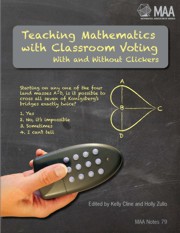Book contents
- Frontmatter
- Contents
- I An Introduction to Teaching Mathematics with Classroom Voting
- II Studies of Classroom Voting in Mathematics
- III Classroom Voting in Specific Mathematics Classes
- 6 Questions to Engage Students in Discussion (Q.E.D): Using Clickers in a Mathematics for Liberal Arts Course
- 7 Clickers in Introductory Statistics Courses
- 8 Using Clickers in a Statistics Classroom
- 9 Engaging Statistics Students with Classroom Response Systems
- 10 Incorporating Clicker Technology in the Introductory Statistics Course
- 11 Using Clickers in Courses for Future K–8 Teachers
- 12 Using Clickers in Professional DevelopmentWorkshops
- 13 Using ConcepTests in College Algebra
- 14 An Example of Multi-Purpose Use of Clickers in College Algebra
- 15 ConcepTests—Classroom Voting: A Catalyst for an Interactive College Algebra ClassroomD
- 16 Using Clickers to Encourage Communication and Self-Reflection in Precalculus
- 17 Writing and Adapting Classroom Voting Questions: New Functions from Old
- 18 Enhancing Student Participation and Attitudes in a Large-Lecture Calculus Course
- 19 Good Questions for Mathematics Eduction: An Example from Multivariable Calculus
- 20 Integrating Classroom Voting Into Your Lectures: Some Thoughts and Examples from a Differential Equations Course
- 21 Classroom Voting Questions that Provoke Teachable Moments in Differential Equations
- 22 Teaching Linear Algebra with Classroom Voting: A Class Period on Linear Independence
- 23 Lesson Planning with Classroom Voting: An Example from Linear Algebra
- 24 Using Clickers to Enhance Learning in Upper-Level Mathematics Courses
- Bibliography
- About the Editors
19 - Good Questions for Mathematics Eduction: An Example from Multivariable Calculus
from III - Classroom Voting in Specific Mathematics Classes
- Frontmatter
- Contents
- I An Introduction to Teaching Mathematics with Classroom Voting
- II Studies of Classroom Voting in Mathematics
- III Classroom Voting in Specific Mathematics Classes
- 6 Questions to Engage Students in Discussion (Q.E.D): Using Clickers in a Mathematics for Liberal Arts Course
- 7 Clickers in Introductory Statistics Courses
- 8 Using Clickers in a Statistics Classroom
- 9 Engaging Statistics Students with Classroom Response Systems
- 10 Incorporating Clicker Technology in the Introductory Statistics Course
- 11 Using Clickers in Courses for Future K–8 Teachers
- 12 Using Clickers in Professional DevelopmentWorkshops
- 13 Using ConcepTests in College Algebra
- 14 An Example of Multi-Purpose Use of Clickers in College Algebra
- 15 ConcepTests—Classroom Voting: A Catalyst for an Interactive College Algebra ClassroomD
- 16 Using Clickers to Encourage Communication and Self-Reflection in Precalculus
- 17 Writing and Adapting Classroom Voting Questions: New Functions from Old
- 18 Enhancing Student Participation and Attitudes in a Large-Lecture Calculus Course
- 19 Good Questions for Mathematics Eduction: An Example from Multivariable Calculus
- 20 Integrating Classroom Voting Into Your Lectures: Some Thoughts and Examples from a Differential Equations Course
- 21 Classroom Voting Questions that Provoke Teachable Moments in Differential Equations
- 22 Teaching Linear Algebra with Classroom Voting: A Class Period on Linear Independence
- 23 Lesson Planning with Classroom Voting: An Example from Linear Algebra
- 24 Using Clickers to Enhance Learning in Upper-Level Mathematics Courses
- Bibliography
- About the Editors
Summary
Mathematics eduction? Aren't I missing an “a” in the middle of that word? No, I mean eduction, a process by which good questions educe, or
draw out latent understanding of how the world works
lead students to build a deep foundation of fundamental understanding
engage students in bringing order to, or making sense of, complex phenomena from basic given facts.
In this article I present some examples of educing questions that were developed and tested via clicker technology through the Good Questions Project. I will summarize some of the student feedback, and the research on teaching and learning that provides a framework for understanding why “educing” questions may be effective.
The Good Questions project grew out of an effort to introduce young instructors to the benefits of teaching by asking. It was inspired by Cornell mathematician David Henderson's rich knowledge and experience of teaching geometry [40] by posing questions that lead students to construct and refine mathematical concepts based on their own experiences. We were also inspired by the success of Harvard physicist EricMazur [55] in using ConceptTests and peer instruction to teach physics. We wanted to develop questions to stimulate thoughtful discussions of key concepts in calculus, and put them in the hands of instructors in their formative years as TAs and postdoctoral fellows. We wanted to know if discussing the questions would lead to better student understanding and better performance in a traditional freshman calculus course.
- Type
- Chapter
- Information
- Teaching Mathematics with Classroom VotingWith and Without Clickers, pp. 127 - 130Publisher: Mathematical Association of AmericaPrint publication year: 2011



